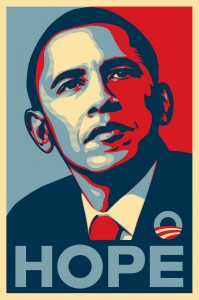 Shepard Fairey is an artist who thrives on controversy. His work seeks to bring change to the government and society. Fairey’s debut began when he distribute “Obey” stickers that he would place around his hometown. Fairey has dedicated his art to publicizing the need for every citizen to posses greater awareness. He incorporates slogans like the above-mentioned “Obey” and “Never trust your own eyes, believe what you are told,” to critique U.S. citizens who blindly follow what the government says rather than doing their own research. His portrait, Barack Obama: Hope, is his most recognizable piece.
Shepard Fairey is an artist who thrives on controversy. His work seeks to bring change to the government and society. Fairey’s debut began when he distribute “Obey” stickers that he would place around his hometown. Fairey has dedicated his art to publicizing the need for every citizen to posses greater awareness. He incorporates slogans like the above-mentioned “Obey” and “Never trust your own eyes, believe what you are told,” to critique U.S. citizens who blindly follow what the government says rather than doing their own research. His portrait, Barack Obama: Hope, is his most recognizable piece.
Though less critical than his previous work, Barack Obama: Hope has still garnered some controversy. This poster was designed to represent then presidential candidate Barack Obama’s life and what it means for the African-American community and American society in general: It was not easy for Barack Obama to grow up being both bi-racial and the product of a single-parent home. The odds were stacked against him, however he managed to deal with his situation accordingly, which brought him all the way the possibility of becoming the first African-American president of the United States. His life and all he has accomplished is an aspiring tale that can bring hope to every child in America that they can achieve great things no matter what their childhood circumstances were.
The poster’s focus, Barack Obama’s campaign, is in itself a controversy. Nearly 200 years after the abolition of slavery there is still a significant struggle with race relations in the United States. Many people questioned if the country was ready for a leader of African-American ancestry. During his campaign, Obama faced several death threats for simply running for president. There was also controversy around Barack Obama’s campaign platform. While citizens were still feeling the pain from an economic recession, Obama promised education improvements, affordable health care, and raised wages for Americans all while cutting the national debt. This was all but enough to cause outrage within the Republican Party.
The scheme also speaks to the life of Barack Obama and the sharp contrast between his difficult childhood and adulthood accomplishments. The portrait is adorned with red, beige, and different shades of blue, which alludes to the American flag. Toward the left of the poster, the background is covered with a light blue tint, which represents his somber childhood. It is not hard to imagine struggling with the absence of his father while his mother bounced him around from country to country. He faced difficulties from poverty in Indonesia to being one of a few African-Americans in his school while living in Hawaii. However, toward the right of the image the poster is filled with bright red. This represents not only his transition into adulthood, but Barack taking control of his life and success he has achieved since then. He attended Columbia University for his undergraduate degree. He was the first African-American president of the Harvard Law Review and received the highest honors when he graduated from Harvard Law School.
Shepard Fairey supported Barack Obama because he had similar ideals for what was right for America at the time. They both believed the government needed comprehensive change in order to re-instate a sense of security for Americans. The placement of Barack Obama’s eyes represents his campaign focus. Rather than looking toward the center of the poster, Fairey aligned Barack Obama’s eyes so that he is looking above the viewer. This is to show that rather than seeking short-term remedies for the issues that America was facing, Barack Obama was focused on seeking solutions that would have long-term effects and actually improve America’s future. This can be exemplified through Barack Obama’s promise of universal health care for American citizens and bringing troops out of Iraq.
Barack Obama’s campaign was platformed with the vision of “hope.” During the presidential campaign America was in a very bad situation. The economy was in recession, un-employment rates were rising, and many families were left homeless and struggling to take care of themselves. Citizens flocked to Obama’s campaign that re-assured hope for a better future in America. This was the reason Shepard Fairey placed “HOPE” under the still-shot of Barack Obama. Barack Obama became the symbol of hope and change for the American people. Fairey uses his work to inspire the same change in citizens that Barack Obama is promising through his campaign. His promises and plans nearly guaranteed that he would bring the United States out of these dark times. During rallies and speeches, on-lookers would often chant “Yes we can.” This was verbal affirmation as to the confidence voters had that as president, Barack Obama would fix the woes that America was facing.
TF
Works Cited
“Barack Obama.” National Portrait Gallery. Smithsonian Institute. Web. 17 July 2015.
http://npgportraits.si.edu/eMuseumNPG/code/emuseum.asp?rawsearch=ObjectID/,/is/,/109700/,/false/,/false&newprofile=CAP&newstyle=single
“BARACK OBAMA TIMELINE.” Barack Obama Timeline. Web. 17 July 2015.
http://www.barack-obama-timeline.com/
“Democratic Party Platforms: 2008 Democratic Party Platform.” Democratic Party Platforms: 2008 Democratic Party Platform. The American Presidency Project, 25 Aug. 2008. Web. 17 July 2015.
http://www.presidency.ucsb.edu/ws/?pid=78283